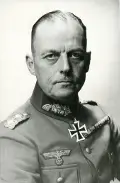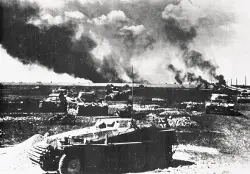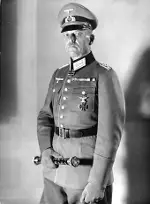German Field Marshal Gerd von Rundstedt
Gerd von Rundstedt was a decorated German officer known for serving on both the Western Front and the Eastern Front during World War II. He is perhaps most well-known for being in charge of the German Army Command in the West when Allied forces landed at Normandy on D-Day. 
Rundstedt was born on Dec. 12, 1875 at Aschersleben. He joined the army at 16 and earned the rank of lieutenant two years later. He got accepted to officer training school at 27 and joined the General Staff in 1907. In July 1914, he joined a division that was part of the First Army, which was deployed as an invasion force into Belgium at the beginning of World War I. He served as chief of staff in a variety of divisions, in both West and East, and was in the Alsace region when the war ended. He was awarded the Iron Cross for his service. He continued in the Army after World War I, rising through the ranks. He gained command of an infantry division in 1932 and successfully navigated the changes in the political structure in the 1930s that saw the rise of Adolf Hitler and the Nazis. Runstedt was at the head of the division that had facilitated the occupation of the Sudetenland in late 1948; shortly thereafter, Rundstet retired. He was back in 1939, leading Army Group South in the invasion of Poland that started World War II and then Army Group A in the takeover of France in 1940. Hitler promoted Rundstedt to the rank of field marshal and then appointed him as overseer of Operation Sea Lion, the planned invasion of the United Kingdom. After the German defeat in the Battle of Britain, Hitler called off the invasion and appointed Rundstedt Commander-in-Chief West. 
His time in the role was relatively brief because he was at the head of Army Group South when it advanced into the Soviet Union in June 1941. The massive attack took the Soviet Union by surprise, and German forces made quick and steady progress. Rundstedt's army played a key role in the seizure of Kiev, which resulted in the capture of more than 400,000 Russian soldiers. Rundstedt's army continued on, as did he, even after suffering a heart attack. His army took Rostov but then lost it again when Rundstedt retreated in the face of a fierce Soviet counterattack. Hitler had ordered Rundstedt not to retreat, but the field marshal did so anyway and was removed from his command. 
Another short retirement later, Rundstedt was back in charge of an army, this time the one defending the Atlantic coast. He assumed the post of Germany Army Command in the West in March 1942 and set about shoring up the defenses along the 1,600-mile coastline from Spain to Norway, known as the Atlantic Wall. Rundstedt actually didn't do a whole lot to augment the existing defenses until another field marshal, Erwin Rommel, arrived in November 1943. The two commanders had their differences, including where to station the vaunted reserve panzer divisions in order to best help repel an invasion by Allied forces. Rommel wanted the tanks near the coast; Rundstedt thought they should be in the rear, to better defend the interior of France. Hitler defused the dispute between the two men by splitting the panzer reserves: half were near the beaches, and the other half were farther east. Rundstedt was in charge and on the case on June 6, 1944, when the D-Day invasion began. (Rommel was on leave because the weather forecast had been so terrible that no one thought the invasions would come.) Rundstedt implored Hitler to release the reserve panzers to help repel the Allied troops, and the Fuhrer finally agreed but not before initially refusing and losing valuable time. Once Rundstedt saw that the Allies had established a beachhead and had the manpower and machines to move east quickly, he (along with Rommel) urged Hitler to order an assembly of a defensive line on the Seine. Hitler refused. Rundstedt later urged the Fuhrer to negotiate a peace agreement with the Allies. Hitler's response was to remove Rundstedt from command yet again. 
A July 1944 plot to kill Hitler failed, and Rundstedt (who was not involved) was one of the officers who served on a Court of Honor to judge those suspected of engaging in the bombing plot. About the same time, he delivered the eulogy for Rommel. Rundstedt gained command in the West again in September and was at the head of a series of defense campaigns. He was nominally the commander of the forces that launched the counterattack known as the Battle of the Bulge, but Hitler had bypassed Rundstedt and his fellow commanding officers and given orders directly to the field commanders. The initial German success was soon replaced by yet another Allied offensive, and the writing was on the wall. Rundstedt was removed from command once and for all. U.S. troops captured Rundstedt in early May. He suffered a heart attack during an interrogation session and was taken to the U.K. After the war, U.K. officials charged with war crimes. By this time, he was in his 70s and in failing health. After being interviewed by a group of military historians, he was released in July 1948, without facing trial. He returned to Germany and died on Feb. 24, 1953. He was survived by his wife, Luise, and their son, Hans Gerd. |
|
Social Studies for Kids
copyright 2002–2024
David White




